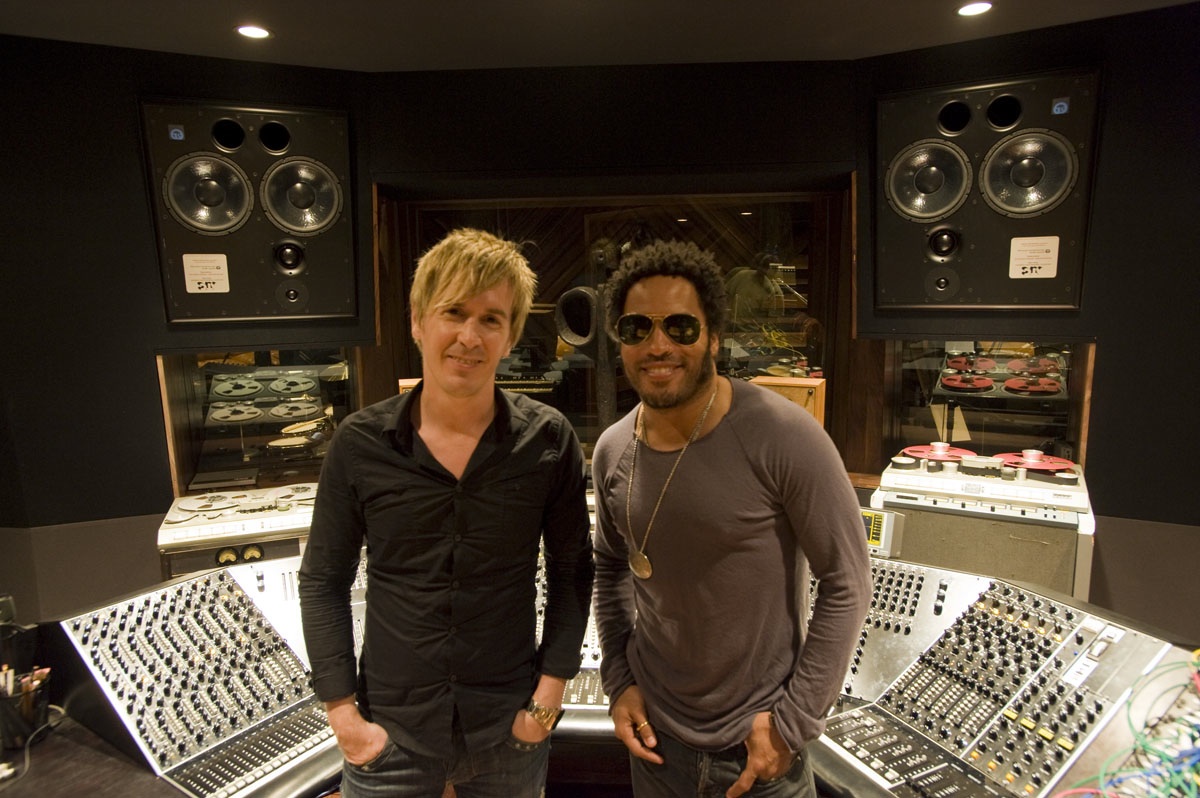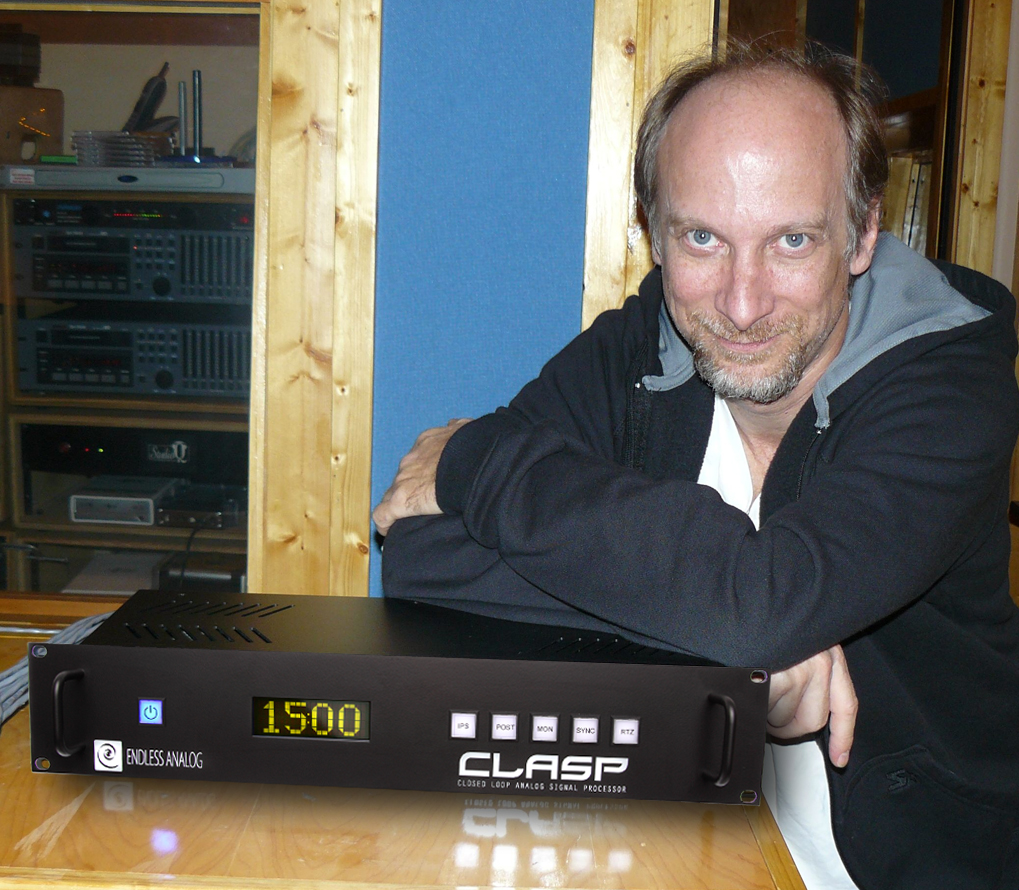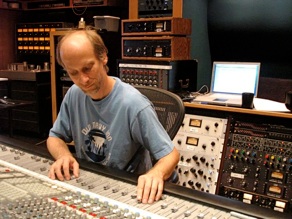How does an audio offering come to life? Welcome to the new SonicScoop series “Research & Development” where we’ll be exploring the genesis of hardware, software and services that catch our eye.
First up: When Endless Analog first launched the CLASP (Closed Loop Analog Signal Processor) in 2010, there was no guarantee that the world would warm up to their system.
Patented by Chris Estes, the CLASP design bridged analog and digital recording techniques by seamlessly integrating tape machines into Pro Tools. The result was the ability to record to tape while maintaining the speed and flexibility of a DAW, delivering real-time analog monitoring with zero-latency through a mastering grade audio signal path.
In 2012, there are no doubts: CLASP is here to stay, with deployments for Lenny Kravitz, Aerosmith, Abbey Road Studios, John Shanks, Nathan Chapman (Taylor Swift), Beck, Michael W. Smith, Denis Savage (Celine Dion), Butch Walker (Panic at the Disco, Pink, Avril Lavigne), Dave Cobb (Shooter Jennings, Jamey Johnson), Chuck Ainlay and John Fields (Jonas Brothers, Miley Cyrus, Switchfoot), and more.
As Estes spent time in the field with CLASP, however, he discovered that something more was needed for the line — CLASP users with multiple tape machines needed an additional level of control. For that, Endless Analog has just introduced a powerful complement to the CLASP line: the Machine Matrix ($3,750). Here, Estes explains how and why his new made-to-order system came into being.
What’s the principle behind the Machine Matrix?
With the Machine Matrix and a CLASP system you can switch back and forth between tape machines in the middle of the song without any patching or re-syncing all with a single mouse click. Machine Matrix is software/hardware controlled analog tape with mastering grade auto signal routing.
What sparked the original idea for this addition to the Endless Analog line?
The original idea for the Machine Matrix came from Lenny Kravitz’ studio. I spent a good amount of time with Lenny at his studio in the Bahamas and he was one of first customers to utilize CLASP with the Studer J37 one inch four track. His J37 was actually used by The Beatles to record Sgt. Pepper.
He has several different tape machines, and and he wants to use them all. So that was the inspiration for creating the Matrix — a seamless way to switch between tape decks during a session that doesn’t disrupt the creative flow. With our old CLASP software you needed a separate template for each machine, but with the Machine Matrix and our version 3.5 software and hardware there is only one master template for all your tape machines, so you never have to stop the creative flow of the session, break down, and connect your Pro Tools and patchbay to the new machine.
With the Machine Matrix it’s just literally as easy as one mouse click, and within the time it takes to click the mouse your CLASP is switched over to a new tape machine, and everything is patched and synchronized instantly.
For example, let’s say your studio has an Ampex ATR ½-inch machine at 30 ips, but you also have a Studer A80 1-inch that’s running at 15 IPS. You could have 20:32 of tape left on the Studer machine, while the Ampex ATR is running at 30 IPS with 07:31 minutes left — it doesn’t matter. The Machine Matrix keeps track of it all. When you switch to the new machine, the CLASP hardware is automatically updated to the newly selected tape deck.
What did you learn from the rollout of the original CLASP – what was surprising/unexpected for you in terms of how studios were integrating them into their workflow, and using some of the features of the system?

(click to enlarge) This diagram depicts a CLASP system installation using pre existing D-Sub patch bays and pre existing wiring. There are 3 patch modes; (1) CLASP mode which requires no patching. (2) Pro Tools Only mode which requires only one patch from the mic pre outputs to the Pro Tools inputs. (3) Analog Tape Only mode which requires one patch from the analog tape deck outputs to the console line inputs. All of the patchbays are half normaled except for bays 1 & 2 (microphone lines to mic pre amps).
One of the things we learned was how to efficiently and economically integrate CLASP into a studio with minimal wiring. We now have a patchbay configuration diagram that uses mostly your pre-existing wiring. And if you already have a DSUB patchbay then it’s even easier. (see diagram) CLASP is designed to be plug-and-play, you take it out of the box, plug it in and go. It only takes literally one minute to install the software in your Pro Tools.
Another thing we learned was how to improve the software interface and its functionality. We had great suggestions from a few engineers at Abbey Road.
So with those in mind I reworked the interface, and in this new version 3.5 you see the culmination of suggestions from our users — a much better GUI where you can see the track arming status of all 24 tracks of the CLASP hardware simultaneously, better functionality such as Input Monitor and Repro monitor controls on the plugin. An auto update feature that scans for track arming eliminating the need to bank through channels manually with HUI. And we’ve put more controls on the plugin to control the hardware, because that’s mostly what the software is doing — controlling our hardware.
In addition to Lenny Kravitz’ studio, can you give us another example of how the Machine Matrix can optimize the CLASP workflow?
The Machine Matrix makes it extremely convenient to work with all of the machines in your arsenal for overdubbing, mix down — you name it. For example; you might decide to track with your 2-inch machine, but then overdub with your half-inch 2-track and then mix. Or you might be in a tracking session and you have two totally different 2 inch machines you want to A/B for a song. Well, now you can A/B without stopping the session.
You’re one mouse click away from any machine you have in your room. It’s possible to have three completely different 2-inch machines, 1-inch machines, half-inch, quarter-inch or any combination all connected to the Matrix at the same time. It takes as long to switch between decks as it does for you to click the mouse.
One of the best examples I have seen is a CLASP studio with two different 24-track machines (Studer A80, MCI JH24) and an ATR 102 that used a different 2-inch for each song at different tape speeds that best suited the vibe of each song while tracking, then switched into the ATR for vocal overdubbing and the final mix processing.
It’s really exciting to see how people use CLASP. A lot of guys are using it in the mix stage now. They insert the half-inch two-track into the mix chain after their bus compressor and set it on “input” using the VU meters on the two-track to keep an eye on the mix buss gain structure. After the mix is about 80% dialed in, they set the two-track into “repro” and take its transport online with the CLASP.
So now Pro Tools is driving the tape transport (automatic) and they are listening “through the tape” and making final mix and buss compression tweaks, letting the tape react to the fast transients instead of their buss compressor. They fold the output of the two track back into Pro Tools on a fresh channel and use a make up gain plugin like the Slate Mastering Plugin to offset the gain difference going from 0db @ -18VU. The results from this are amazing.
What’s the most challenging aspect of designing an entirely new product, as you’ve done with the Machine Matrix?
I think the most challenging thing is to do it so it integrates with our pre-existing lines — that’s what I set out to do. Seamless integration was the goal: When you have a Machine Matrix and want to plug into a CLASP 8, 16, or 24, you’re there. It just plugs in and sees it.
The form factor also takes a lot of careful consideration. Originally we were going to make the audio routing and machine control routing of the Matrix as a separate pieces of gear, but in the end we decided it made more sense to put everything together — that this would give the customer more value. Fortunately it wasn’t difficult to integrate! I just had to re-work the circuit board designs.
Lastly, why is product evolution an essential part of what you do – what are the market forces that make new product features and models a necessity for manufacturers like Endless Analog?
As a music artist it is necessary to keep writing, performing and inventing. I used to write songs and make records — that’s what I did for a living, and then I had the idea for CLASP because I was feeling frustrated about how my digital recordings were sounding. So this is just me being an artist, just like when an artist writes a new song: You have the song in you, you want to get it out and make it happen you want to see it materialize. These are my songs in the form of gear.
Eventually CLASP will be a lot more than what you see right now. It took about five years for us to get the first patent issued for CLASP, which is kind of like getting your songs copy-written. So these first pieces of Endless Analog CLASP gear are like the first few tracks on an album that has been written. Now we’re recording the rest of the album for release a few tracks at a time and hopefully people will continue to like our music.
Just like we each like different genres of music, some engineers like plugins, and that’s fine. But when it comes down to it, we like the sound of using the real thing any day over a simulation. And why not use the real thing if you can? A real tape machine running in the studio is always way more inspiring than a plugin any day.
– David Weiss











